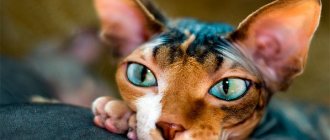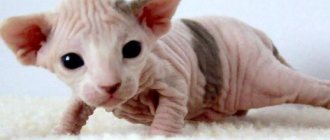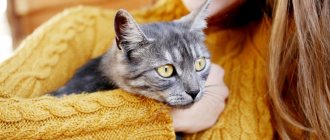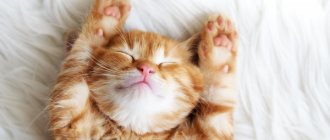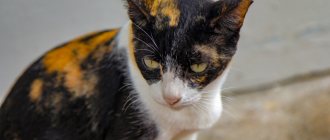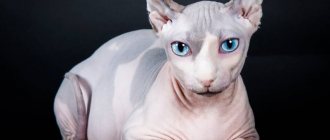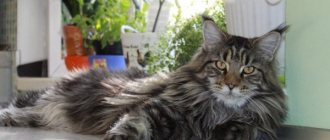Video
* We invite you to watch a video about the Sphinx . In fact, in front of you is a playlist in which you can select and watch any of 20 videos about a given cat breed by simply clicking on the button in the upper right corner of the window. In addition, the material contains quite a lot of photos. By looking at them you can find out what the Sphinx looks like.
In this article:
|
Rate the material!
[Total votes: 4 Average: 5]
The Sphynx is a graceful cat that has gained popularity relatively recently. Not many people know that hairless cats existed long before the development of civilization and were also revered by ancient people. Today, sphinxes are smart and kind animals that are always ready to make contact with people.
How to choose the right kitten
A hairless kitten, the price of which can vary from 400 to 1,500 dollars, must be chosen very carefully, paying attention not only to the cost, but also to the living conditions of the babies and mother. If owners do not take care of their pets, then the kitten you choose may have health problems. Proper maintenance and nutrition in the first months of life are very important for the formation of strong immunity.
It is imperative to study the pedigree. There should be no suspicious relatives in it, even in the distant “past”. It would be good if the owners provide detailed information about the health status of the parents, and ideally the grandparents too). This will allow you to be “prepared” for the fact that a particular disease may develop if the kitten has a predisposition to it.
Before giving a kitten to a new family, good breeders always take care of such points as:
- registration of a veterinary passport;
- preventive deworming;
- primary vaccination.
Important! Never take lethargic and passive kittens, no matter how the breeder explains this behavior. Healthy kids are always inquisitive, sociable and active. Also, you should not take kittens that are too small; it is better to wait until 2-3 months so that the baby gets stronger and is already independent.
Familiarize yourself with the standards for the breed you have chosen in advance, and follow the list of signs when choosing your pet. Be sure to take the owner's business card and ask what club he belongs to. Decent people will always cooperate:
- they will help you with advice, even if you have already bought a pet and some time has passed;
- they will suggest a good veterinarian whom they themselves turn to;
- They will tell you what food is best to feed, what to wash and how to care for it.
Important! Refrain from purchasing if the owner evades answering your questions, does not provide advice, if the animal does not have a passport or if no preventive measures have been taken at its age.
History of the origin of the sphinxes
Sphynxes are one of the oldest cat breeds. There is evidence that they existed in ancient Egypt, when the white, blue-eyed sphinx guarded sacred places. The ancient Aztecs also had cats without hair; resourceful people used them as living hot water bottles.
Ancient breeds of hairless cats disappeared for various reasons, therefore, we can say that modern Sphynxes were bred artificially. For example, in the USA at the beginning of the 20th century, there was an exhibition where the Mexican hairless cat was shown - the closest relative of the ancient hairless cats. Unfortunately, the Mexican hairless disappeared completely by the thirties, because they could not leave productive offspring.
Hairless kittens can appear in furry cats, regardless of their breed. In 1938, biologist E. Letard from France began studying mutations that were observed in hairless kittens from a Siamese cat. In parallel, hairless cats had already been studied in Scandinavia and England, although these were only studies and not attempts to recreate the ancient breed.
The breed dates back to 1966, when another hairless kitten appeared in Canada from an ordinary domestic cat. The kitten was named Prune and was bred with its mother, resulting in both furry and hairless kittens. It was Prune who was crossed with his relatives in order to get as many hairless kittens as possible. However, the breed had not yet been formed, and the population was small. In addition, the kittens had weak immunity and often died.
The story of the Sphynx could have ended if in 1975 a hairless kitten had not appeared in Wadena from an ordinary short-haired cat. The kitten was ironically named Epidermis. Afterwards, a hairless cat was born there, and both individuals were placed in a nursery. This is how the Sphynx breed began - they successfully reproduced and gave birth to hairless kittens.
A little history of the breed
Hairless cats have been known to people since ancient times. It is believed that these purrs served in the temples of the ancient Aztecs. Cats helped the Indians receive the blessings of the gods. In 1903, Francis Simpson described Mexican hairless cats in The Book of Cats. Later, reports about these marvelous animals began to arrive from different parts of the planet. There have been cases where hairless kittens were born to the simplest cats. The breed was first registered in 1966. Then an unusual kitten was born - hairless, and scientists were eager to breed a new breed. Subsequently, its representatives will be called Canadian sphinxes. Unfortunately, during that period, felinologists made many mistakes in breeding and keeping such animals. Over time, scientists have accumulated experience and knowledge. Hairless cats are now quite popular as pets.
Sphinx - description of the breed
In fact, sphinxes are not completely devoid of fur: their skin is soft and velvety to the touch. The Sphynx's fur is so short that it is almost invisible. Some Sphynx breeds have some hair on their face or paws, although most Sphynx breeds appear completely hairless. Also, these cats do not have whiskers.
Today there are three generally recognized breeds of Sphynx, which are registered by the Association of Cat Fanciers.
These include:
- Canadian Sphynx. This breed has been around for 60 years. The body of the Canadian Sphynx has inconspicuous fluff and many folds of leather. They have large expressive eyes and large ears. The body is smaller in size than that of a normal cat;
- The Don Sphynx was bred in Rostov-on-Don. They are quite large and have a lot of folds. The body is more massive and short - they are very reminiscent of an ordinary domestic cat without hair. Sometimes a small amount of soft fluff is allowed on the bodies of Don Sphynxes, which curls into curls;
- The Peterbald or Petersburg Sphynx is a breed obtained by crossing with graceful Oriental cats. Thanks to this tandem, the breed turned out to be very elegant: an elongated head, narrow eyes and long ears. The body is refined, elongated. Peterbalds may have a small, smooth coat.
The Sphynx cat continues to change and improve.
So far, the most popular and stable are the Canadian Sphynxes. All sphinxes have well-developed muscles, which makes them, even with all their elegance, quite strong animals. The tails of sphinxes are also completely devoid of hair, and are always slightly curled into a spiral at the end.
Sphynx Peterbald
This branch of the breed appeared as a result of crossing an Oriental cat and a Don Sphynx. It was created in 1994. The body structure of the purr is similar to representatives of breeds that are covered with wool. The Peterbald, like all other sphinxes, is hot to the touch. These cats are very attached to people. But when they are in a bad mood, it is better to avoid them, otherwise you will be bitten or scratched. Although in general these animals are very calm and docile.
Representatives have a wedge-shaped head, a long nose, and a slender, strong figure. Their limbs are thin, high, and their paws are elastic. These cats have large ears.
Many people believe that the Peterbald is a “hairless” Oriental cat.
These purrs come in different colors:
- blue;
- lilac;
- color point;
- chocolate;
- cream.
Now let's look at little-known, exotic breeds
Popular Sphynx colors
Sphynx cats come in a variety of colors, many of which differ from standard cat colors.
In general, cat colors are classified as follows:
- Solid - the color of the cat's body is uniformly one color from the whiskers to the tip of the tail. The color is necessarily intense;
- Tortoiseshell - a combination of several colors, in particular black and red. There are no strict requirements for tortoiseshell colors, since during selection they are modified in every possible way;
- Tabbies are striped, spotted and marbled cats, in which a contrasting pattern is clearly visible;
- Bicolors - a combination of white and primary colors;
- Colored cats are the color of Siamese cats.
In particular, the following colors are available for Sphynxes of various breeds:
- Classic: white, black, blue, red, cream, chocolate;
- Lilac – gray with a pinkish tint. The nose and paws remain bright pink;
- Cinnamon – brown color;
- Background – pale pink color;
- Classic tabby - with markings on the paws and tail, curls on the cheeks. Original color with many markings consisting of lines and spots;
- Mackerel - the legs are colored in rings that smoothly turn into markings throughout the body;
- Spotted tabby - markings on the body in the form of spots;
- Thorby is a tortoiseshell color that combines silver, blue, red and other colors;
- Silver, brown, blue, red, cream tabby;
- Calico - aka chintz. White color with pale black and red spots;
- Van Calico - white with blue and cream spots;
- Point - a color in which numerous points of different colors are located on the body of the sphinx;
- Sable – brown color without any markings;
- Platinum is a honey-beige color of a cat.
Health and life expectancy
The average life expectancy of sphinxes is 12-15 years.
Following the requirements of proper nutrition and a balanced diet, these cats rarely visit veterinary clinics. Health problems are often caused by hypothermia and poor hygiene. Problems may arise due to the animal's prolonged exposure to sunlight. However, there are diseases characteristic of sphinxes - urticaria, various skin irritations, rashes. For them, one of the health problems is hypertrophic cardiomyopathy.
With it, the septum between the ventricles of the heart suffers. However, geneticists have no evidence that it is associated with poor heredity. Another disease is myopathy - it is inherited. This disease is common in Devon Rex dogs. The Sphynx's body temperature normally reaches 39 degrees, which is much higher than that of other cat breeds.
Character and habits of sphinxes
Sphynx cats really need human interaction, and this distinguishes them from many other cat breeds. They are loving, love to sit on laps, and enjoy being petted. The Sphynx does not like to be alone for a long time, so these cats are not suitable for people who are always busy at work.
Sphinxes are completely non-aggressive, friendly and friendly. They are ready to meet new people, willingly allow themselves to be petted and prefer not to show aggression. These cats are well suited for families with children, as they love to play and will never offend a person. You can choose to overcome obstacles as games with sphinxes - these cats are excellent at learning.
Interesting fact: Sphinxes do not have a tendency towards vengeance, and they are not at all vindictive. At the same time, sphinxes are extremely vulnerable animals, so you should treat them kindly and friendly. You should not yell at them, much less hit them, as this can make the cat depressed. Sphinxes easily get psychological trauma, which is why their life expectancy is reduced.
Sphinxes are very curious. They love to climb into inaccessible places in the house and always pay attention to new objects. Therefore, they should hide prickly and cutting things, since curious cats will definitely get to them.
The Sphinx will never perceive itself as inferior to a person. Only partnerships are possible with these cats, in which the sphinx is a full-fledged member of the family. Because of this, you should not expect that the Sphinx will unquestioningly obey and carry out commands. Therefore, it is generally accepted that these cats are characterized by stubbornness and pride.
Sphynxes get along well with other animals, they are not even afraid of dogs. At the same time, the sphinx will not be jealous of the owner of other pets if they devote enough time to everyone.
Character
Connoisseurs of hairless breeds dote on their pets and can forgive them everything for their wonderful character. Such cats become attached to all family members, but choose one person as their favorite owner. Purrs understand words very well and react to changes in mood in the family.
Thanks to their cheerful and loyal disposition, Sphynx cats can be excellent companions for children.
Hairless cats suffer greatly from loneliness. Therefore, it is recommended to keep them only for those who spend a lot of time at home.
Interesting facts about sphinxes
Contrary to popular belief, Sphynx cats are an ancient breed of cat, but this is not entirely true. Ancient hairless cats became extinct for various reasons, and sphinxes are an artificially bred breed that was created due to mutations.
Typically, Sphynx cats live for about 14 years. The longest living cat of this breed died at the age of 19 years. The key to success in the longevity of these cats is proper care and a minimum of stress.
Sphynxes are very hot animals, as their body temperature reaches 39 degrees Celsius. It was not for nothing that the ancient Aztecs used sphinxes as living hot water bottles. Given their temperature, cats of this breed are extremely heat-loving and cannot tolerate cold weather.
Sphynx cats are suitable for people who really want to have a cat, but are allergic to fur. The absence of hair is also a plus in caring for a pet. Sphynxes love to swim in warm water.
Newborn Sphynx cats have drooping ears, and their body is covered from head to toe with folds, some of which straighten out with age.
Hairless cats were considered sacred in many nations. Their gracefulness was glorified in antiquity, and the cult of cats in ancient Egypt did not bypass the oldest representatives of hairless cats.
Sometimes sphinxes do show aggression, but this is not the norm for their behavior. Aggressive sphinxes are cats that have suffered some kind of stress or received psychological trauma. Such cats should be gradually rehabilitated, but trust will be extremely difficult to restore.
Sphynx cats have very sensitive skin. They should definitely be stroked and scratched, as this gives them pleasure, makes them happy and even more attached to their owner.
What to feed bald pets?
Pets without hair eat more often than others due to accelerated metabolic processes in the body.
A hairless cat not only looks exotic, but also requires specialized nutrition, which is selected by veterinarians. Energetic, active animals have a high metabolism, so they love to eat. You need to be careful not to overfeed the cat, as this can disrupt metabolic processes, lead to obesity or provoke an allergic reaction.
Veterinarians note that the diet of a hairless cat that is not prone to allergies should consist of protein - 60%, fats - 10%, carbohydrates - 30%.
If your animal has a reaction to certain foods, you should consult a specialist. He will select suitable dry food that will help balance the pet’s diet. Specialized mixtures have certain advantages:
- high protein content;
- strengthen the cardiovascular system;
- clean teeth from plaque;
- preservatives and chemical additives are excluded;
- do not contain allergenic components.
Hairless cats are exotic representatives of the animal world that originated in the territory of modern Russia. Later, breeders began to cross them with other breeds and got beautiful pets that will become faithful companions for humans. The level of appearance is comparable to the demands on care, since cats suffer from allergic reactions and problems associated with the lack of fur.
Pros and cons of sphinxes
The most obvious advantage of Sphynx cats is the lack of hair. Cats do not cause allergies, they do not need to be combed, and the hair that falls out does not settle on clothes, furniture or the floor. Like fluffy cats, Sphynx cats are pleasant to the touch and love affection in the same way.
Sphynxes are affectionate and loving – this is also a plus for ardent cat lovers. Sphinxes will always be happy to be stroked and will never refuse to sit on their owner’s lap. They love to sleep with people under a blanket and, moreover, sphinxes are very warm, so they can even warm their owner.
Fun fact: Sphynx cats are smart and easy to train. They will be happy to perform simple tricks if you handle the animal correctly. They usually willingly make contact with people who have always been respectful to them.
Sphynx cats love to play, so they can be kept in families with children. They also get along easily with other animals. Sphynx cats are in good health, although regular check-ups by veterinarians should not be neglected.
Sphynx kittens are born strong and healthy and quickly open their eyes. Sometimes little sphinxes are born sighted. Also, since childhood, they have a good appetite and willingly eat both homemade food and feed.
Sphinxes also have negative sides. The most basic of them is that cats sweat a lot. The fact is that in ordinary cats all the sweat is absorbed into the undercoat and evaporates, but Sphynx cats do not have such an undercoat. Their sweat has an odor and an unpleasant brown tint. If a cat sweats while sitting on light-colored furniture or clothing, the stain will certainly remain. Such stains are almost impossible to remove.
Sphynxes are playful and curious, and if they are not provided with the necessary toys, they will find them themselves: they will rip curtains, eat pins and do other unpleasant things. Sphynx cats are also clean, so they won’t want to visit a litter box that already has a strong smell.
How did hairless cats appear?
Each breed of hairless creatures has its own history, but the first mentions of these unusual creatures are associated with the Aztec civilization, so Mexico was considered their homeland. Animals were sacred, and the Aztecs believed that they gave their wool to their owners, saving them from the cold. Mexican cats were first described in the Book of Cats at the beginning of the last century. However, the last hairless Mexican cats, Nellie and Dick, left this world back in 1930.
But, as it turned out, Mexico is not the only country where strange hairless creatures lived, which appeared as a result of natural mutation. They lived in warm countries: Paraguay, India, Iran.
Hairless cats differ from their counterparts not only in their unusual appearance. They have very thick skin, so giving them injections, especially in the withers area, is very problematic. Interestingly, they feel virtually no pain.
Another feature of cats is that, due to the lack of a “fur coat,” they seem hot. But in fact, the body temperature, like other cats, is 39 degrees.
The following fact cannot be ignored. Hairless kittens can suddenly appear in an ordinary short-haired cat, or even a purebred one. Breeders are still working on developing new breeds. So perhaps the story of hairless cats is just beginning.
Breeding Sphynxes
Reproduction of Sphynx cats requires special attention, and breeding of cats of this breed should only be done by people who already have experience in breeding cats. It is important to know how Sphynx puberty proceeds, how to choose a partner for mating and how to deliver a cat so that everything goes well.
Cats mature around the seventh month of life, but it is still too early to start breeding them. It is important to wait out the first heat: the sphinx begins to scream and fuss. Changes occur in its behavior: cats can become both very affectionate and aggressive. The Sphynx's body is still developing, so you should just wait out this period if you are not going to sterilize the cat.
Males mature around the eighth month of life. They are not yet ready for mating - readiness can also be understood by a change in behavior: the pet is actively marking its territory and becoming aggressive.
The first mating can be carried out after the cats are one and a half years old - during this time the cat goes through at least three heats. By this age, animals must be fully vaccinated and healthy, otherwise there is a risk of getting sick offspring. Cats cannot be vaccinated after mating.
Before mating, animals must be checked by veterinarians to ensure that there are no accidental diseases. Before mating, the animals' claws are trimmed so that they do not accidentally fight. It is better to give the cats time to get used to each other a little and get to know each other. The smell of the cat should attract the male, so everything will go naturally. Sometimes mating alone is not enough, so cats must spend several days with each other.
Pregnant cats become lazy and affectionate. Pregnancy lasts 63 days, but delayed births are not uncommon among this cat breed. Sphynx cats usually give birth on their own without complications. In general, a cat can bear up to 12 healthy kittens. Kittens are born healthy and strong, and open their eyes very early.
Video text
SUBSCRIBE TO THE CHANNEL: https://bit.ly/findpet GUIDE DOG FOR A DOG HISTORY —
Where did hairless cats come from?
The first mentions of hairless cats date back to the times of the Aztecs. More recent information about them was found in India and Morocco. In the 1960s, the first hairless cats were bred in Canada. The breed was called the “Canadian Sphynx”.
A domestic cat in Toronto gave birth to a hairless kitten. Some time later, in the USA the situation repeated itself: a hairless kitten was born from a simple cat.
We recommend reading: Cat vomits yellow crap after castration
So, gradually, by crossing rare representatives of these individuals, the number of sphinxes grew. Today the Canadian Sphynx breed is one of the most popular.
Canadian Sphynxes are strong, slender, with large ears and no whiskers at all. The first representative of this breed lived 28 years.
Where did hairless cats come from?
Sphynx care
First of all, care concerns the skin of sphinxes. Since cats sweat profusely, they need to be washed and wiped with wet wipes. A crust may even appear on unkempt skin, which can cause dermatitis.
When bathing sphinxes, you should follow the following rules:
- The water temperature should not exceed 38 degrees;
- If you are bathing a kitten, you should lower it into the water slowly. It is worth placing a rubber mat on the bottom to prevent it from slipping;
- You should only use special shampoo for sphinxes;
- The towel you wrap your Sphynx in should be soft and terry, as other material may irritate the skin;
- You need to hold a wet Sphynx in your arms until it is completely dry, otherwise the animal will catch a cold;
- Under no circumstances should you dry it with a hairdryer;
- You can use a special moisturizer to soften your skin after swimming.
Sphynxes are bathed once a week, but every day it is worth wiping them with special napkins and dry towels so that sweat does not accumulate on them.
It is worth understanding that sphinxes do not have any protection, which fluffy cats have. Therefore, their ears should be cleaned regularly with chopsticks to prevent wax from accumulating in them. Sphynx teeth should also be cleaned of dirt with special pastes.
The lack of eyelashes also makes Sphynx cats vulnerable to dust and dirt. It is worth regularly cleaning the corners of the eyes with cotton swabs, and also having your cat examined by a veterinarian for eye diseases.
Since Sphynx cats are not protected from the sun's rays, they can get sunburned. It is worth monitoring how long cats lie in the sun so that they do not get burned. Burns should be treated with special ointments.
Care and its features
An important element of caring for such an animal is bathing it.
Hairless cats have unique external characteristics that are not accepted by everyone. For some people, hairless pets are beautiful, for others they are scary. However, caring for them requires serious energy and monetary costs. The main rules that should be followed if hairless cats settle in the house:
- Regularly clean your pet's skin of dirt with wet wipes (those containing alcohol are not allowed).
- Bathe weekly with specialized shampoo (water - 38C).
- The ears accumulate black secretions, which are removed once every 7 days with cotton swabs or specialized solutions.
- Keep hairless cats away from heating sources, as they can injure the skin.
- Care in the summer requires the use of sunscreen, which will protect the animal from burns.
- The cat needs to wash its eyes with chamomile decoction to avoid the development of infections.
Sphynx diet
Sphynxes are unpretentious in food and do not require a special selection of diet. Of course, if this is ready-made food, then preference should be given only to premium food. Little kittens feed on their mother's milk for up to one and a half months, which provides them with everything they need. At two months, kittens should be given special supplements or ground boiled chicken breast, beef, or chicken egg yolk. Ready-made food is pre-soaked in water.
After the kitten is taken from the nursery, it is worth feeding it the same food that the breeder fed it. This will minimize the stress the kitten experiences when separated from its mother. Nutrition according to the new scheme should be introduced gradually a week after weaning.
In no case should you feed Sphynxes food from the table - they are prone to overeating and are ready to eat even what cats do not eat in principle. Although hairless cats do eat more than fluffy ones, since they spend much more energy on keeping warm. For example, a two-month-old kitten is fed up to eight times a day, so it is necessary to feed even at night.
If you are choosing homemade food for your pet, then it must include the following components:
- Daily – beef, rabbit, poultry (alternate);
- Boiled offal several times a week;
- Cereals such as corn, wheat, rice or buckwheat;
- Egg once a week;
- Carrots, zucchini, broccoli, cabbage and other greens up to three times a week;
- Daily vitamin supplements.
The best option would be to make a piece of minced meat, add an egg and vegetables to it, and also add a few drops of vitamin D - healthy food for your pet is ready.
Where did cats come from and where did they come from?
The history of cats is still shrouded in mystery. Today it is known that ancient people depicted these animals in manuscripts and drawings 10-15 thousand years ago.
Each breed, each type of cat has its own unique history, which dates back to ancient times. A lot is known about cats, but not everyone knows where cats came from, why they began to live side by side with humans, where their history began in Russia and how they spread throughout the world.
A cat is a genus of mammals from the cat family, the order is carnivores. There are currently about 600 million pets around the globe.
Cats descended from forest and steppe ancestors who were wild for a long time.
The word cat comes from the Old Russian word “kotka”, which in turn comes from the Latin - “cattus”.
Scientists are still arguing about the origin of these animals on Earth. At the moment, there are two known theories - one biblical, and the other scientific.
The first theory-legend tells that during the Great Flood, rodents appeared on Noah’s ark, which posed a danger to the animals from the ark. Then the lion clan gave birth to cats, who dealt with all the rodents and saved the living creatures from them.
The second theory says that the first cats on the planet appeared long before their domesticated relatives, namely about 60 thousand years ago. The prehistoric predecessor of cats is considered to be the ancient inhabitant of Madagascar - the Fossa.
Many zoologists believe that the ancestor of cats was Proaiurus, a currently extinct species.
It gave rise to two branches:
- Ancient saber-toothed cats (extinct).
- Representatives of modern felines.
If we look at historical reports and genetic analyses, the first domestic cats were discovered in ancient villages about 10 thousand years ago.
Domestic cats spread across the globe in two waves. The first wave occurred at the height of agriculture, about 9-12 thousand years ago. And the second wave began in Egypt and gradually spread to all of North Africa and Europe several thousand years later.
Many scientists believe that it was in Egypt that the domestication of animals began.
Three species are known to live in Ancient Egypt:
- The steppe cat (or African) is the most common. Similar to a regular one, but the size is larger and the legs are longer.
- The serval is a nocturnal animal native to Nubia. Also, the sizes are larger than those of animals familiar to us. The main difference is the large ears.
- The jungle cat lives in wet, wet areas. Large, weight reaches 10-15 kg, but short legs.
The domestication of animals began with the fact that in Egypt, grain collected from the fields was eaten by rodents. When people noticed that cats were hunting them, they began to attract them. This is how pets began to exist side by side with humans.
It was for these merits that cats were dubbed sacred animals that protected supplies and saved people from hunger. If we turn to Egyptian ancient sources, we can see that God Ra was depicted with a cat's head, and the Goddess of Fertility was depicted as a cat.
To better understand how people treated these animals, here are some interesting facts:
- 1. People even built temples for cats, where the dead were mummified. The death of an animal was perceived as the death of a relative, and in honor of him, family members shaved off their eyebrows.
- 2. Cats were considered the property of the state and it was strictly forbidden to export them.
- 3. A cab driver who accidentally ran over an animal was stoned to death.
- 4. In the battle against King Cambyses, the opponents tied cats to their shields, the Egyptians did not attack and lost the war.
- 5. If a disaster came to the city (for example, a fire), then these animals were rescued first, the children were next in line.
- 6. Rulers and clergy listened to the emotions of cats, as it was believed that they could speak with the gods.
It is still unknown exactly where cats came from in Russia, but it is known that in the 12th century animals already lived in Rus'. They were in small quantities and were worth their weight in silver, like oxen and other arable animals. Therefore, not many could afford them.
For murder, as in ancient Egypt, punishment was imposed - but more lenient - a huge fine, because it was these animals that saved the crop from rodents.
By the 15th to 18th centuries, cats became more common and could be afforded by ordinary people. But closer to the 19th century, there were so many of them in the villages that the peasants handed them over to special people for their skins. Then the clergy, concerned about the cruel behavior of people, again issued a decree to protect these animals. Special openings were even made in the temple gates to make it easier for pets to enter.
Over time, cats spread widely throughout Rus'. They were considered an attribute of wealth and prosperity. A decree was issued stating that every store must have a cat that ate mice, thereby protecting people from dangerous infections and epidemics.
Pets were ordered by rich people from Holland and other countries. The animals lived at the court of Catherine the Great, daughter of Peter the Great and Nicholas the First.
From those times came proverbs and sayings related to pets. In mythology, it was believed that cats help the brownie in his work. Black cats are known to be especially shrouded in myths and legends. It was believed that through black animals the brownie learned about the affairs of the family who lived in the house. They were believed to be the best mouse hunters.
We recommend reading: Dermatitis in Cats Is Transmitted to Humans
A ritual that has survived to this day is that the cat should be the first to enter a new house. Then in such a house there will always be order, prosperity, comfort and a lot of positive energy.
There are holidays dedicated to pets. In Russia it is March 1st, and in the world it is August 8th - World Cat Day.
According to statistics, at the moment there is one pet per 4 families. Among them there are all kinds - simple, outbred or rare and purebred. A little history about the most common breeds.
It is still unknown exactly where cats came from in Russia, but it is known that in the 12th century animals already lived in Rus'. They were in small quantities and were worth their weight in silver, like oxen and other arable animals. Therefore, not many could afford them.
Diseases and health problems
Sphynxes have a very strong immune system, so with proper care they will not catch colds or suffer from infectious diseases. But these animals have a number of birth defects that can manifest themselves in one form or another.
For example, the so-called “carp bite”, in which the lower jaw of the sphinx is slightly shortened. Cats' incisors do not touch, the jaw becomes warped, and tooth asymmetry occurs. Due to the fact that the teeth dig into the hard palate, ulcers and wounds constantly appear on it.
There is also a disease called microphthalmia, in which kittens’ eyes develop incorrectly, causing them to decrease in size. This is fraught with many eye diseases that need to be monitored by a veterinarian. Sometimes cysts and tumors appear in the eyes. A similar disease is entropion of the eyelids, which causes animals to suffer from conjunctivitis for life.
Important fact: Curvature of the caudal spine is also not a rare occurrence among sphinxes. Often kittens are simply born non-viable and die early. This disease is fraught with intestinal abnormalities, a weak digestive system, short stature and underdeveloped thoracic region.
Nipple hyperplasia occurs among female Sphynx cats and is inherited. It usually affects cats with light blue or blue-cream skin and blue eyes. It is impossible to diagnose it immediately, but it appears gradually. At the age of one year, kittens' nipples turn red, and the skin around them gradually thickens. Cysts may appear.
Cats with this disease should not be bred. Cubs can be born with pathological internal organs, which is why they often die. These cats also produce very little milk. Hyperplasia can occur if a cat is given hormones that suppress sexual desire.
How much does a sphinx cost?
The price of a pet depends on the purpose of its purchase. A hairless Sphynx cat for the soul costs 5-10 thousand rubles. If the owner plans to participate in exhibitions and engage in mating, then hairless cats cost up to 300 thousand rubles.
A cat is cheaper than a cat. A breeding cat costs more than a cat, although usually the cost of a male of other breeds is higher than that of a female. You should contact nurseries for a kitten.
When purchasing, you need to know the following facts about the Sphynx:
- The kitten should be playful.
- When purchasing, bring a basket or carrier with you. If it's cold outside, put a blanket on it.
- In a new place, the kitten needs time to adapt.
- It is better to adopt a kitten from a nursery or from responsible breeders when it is at least five months old.
